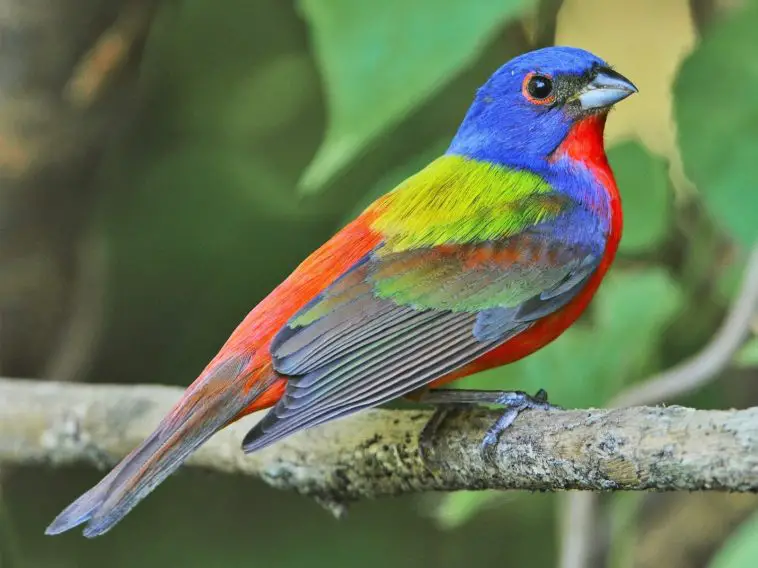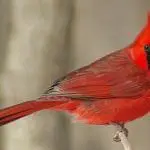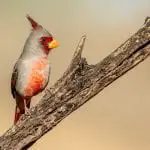Scientific Facts
| Common Name | Painted Bunting, Passerin Nonpareil, Azulillo Sietecolores |
| Scientific Name | Passerina ciris |
| Length | 4.7 to 5.5 inches |
| Life Span | Over 10 years |
| Clutch Size | 3 to 4 eggs |
| Habitat | Close to the ground in Bushes, Shrubs, Hedges, Thickets, Weeds |
| Country of Origin | United States, Mexico |
Physical Description
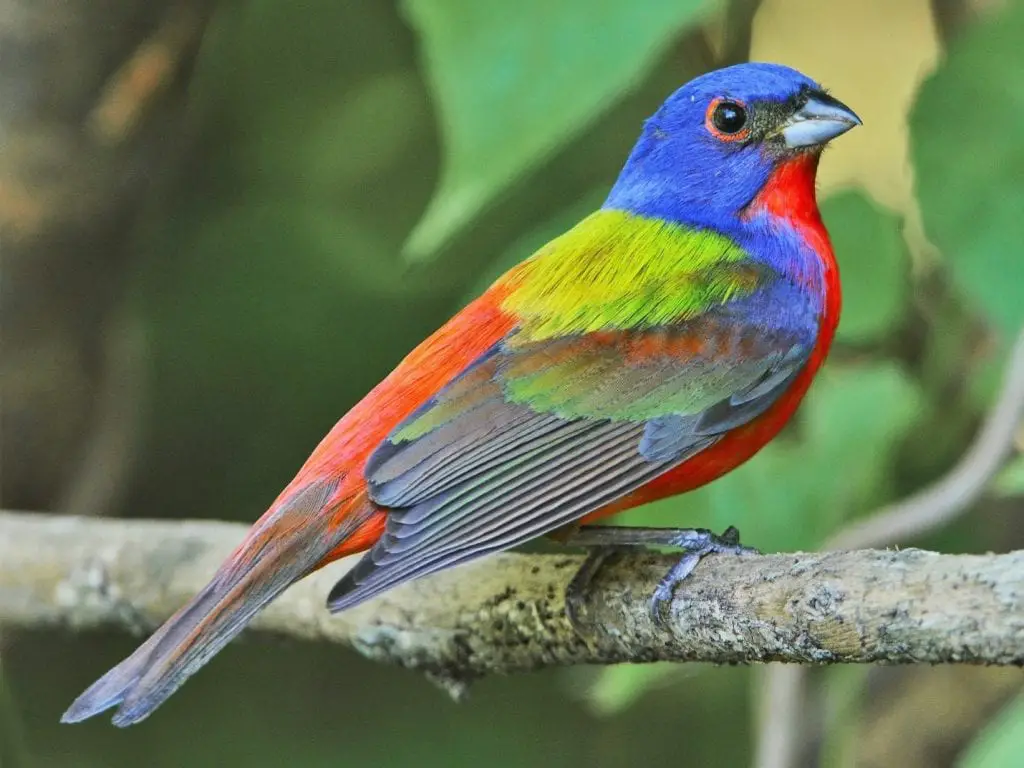
Painted buntings are colorful, bright, and cool birds that are fun to observe using a pair of binoculars. They belong to the cardinal family. It is quite interesting to know that they are the only species of the cardinal family that is native in North America.
These birds are very popular because of their eye-popping plumage of colors. The appearance of painted buntings depends on their gender. Males, for example, feature a plumage that is likened to a box of crayons. They have a bright blue head, redbreast and belly, and an orange eye-ring. It has a greenback, with wings that come in a combination of blues, greens, and purples.
Females and juveniles, on the other hand, are attractive while featuring a solid emerald color. This appearance helps them to hide in vegetation while learning to fly or incubating eggs. The attractive plumage of painted buntings is also a reason why they are hunted for the pet trade. Females retain their color throughout their entire life, while young males will start to grow their rainbow feathers when they reach maturity.
Both male and female painted buntings come in a size of about five inches in length, making them a bit smaller compared with most bluebirds. Male painted buntings are considered to be the most beautiful bird in North America, which usually reach up to 8 to 9 inches in size. These birds weigh about 0.46 to 0.47 ounces. They are also among the most popular visitors in bird feeders.
When these birds stretch out their wings, they reach up to a double body length. They reach a wingspan of up to 8.3 to 9.1 inches. Because of their highly attractive appearance, together with their warbling song, they usually live out as cage birds all their lives. Capture for the pet trade and habitat destruction has resulted in a decline in their numbers since the mid-1960s.
Interesting Facts
Here are some interesting facts about painted buntings:
- This name of this species uses the French term “nonpareil,” which means “without equal.” This refers to the splendid plumage of this bird.
- The name of this species “ceris” comes from the Greek myth. The story behind this myth involves a princess named Scylla, who turned into the sea bird keiris.
- Painted buntings are considered as among the most attractively colored and visually gorgeous birds in the United States. Also, they are the only bird in the United States to feature a blue head with red underpants.
- Male painted buntings show displays of short flights, along with rapidly beating wings. They may present unique flight patterns, such as “moth flights,” which showcases a slow descending flight along with a wing-quivering display. Another type of movement is “butterfly flights,” which features slow and deep wing beats, combined with an undulating flight.
- According to an Indian legend, when a great spirit blessed colors to all birds, he ran out of the dye. Since the painted bunting was the last one to receive colors, he got received a plumage filled with many colors out of the dabs that were left.
- The oldest wild painted bunting recorded to live by a Florida banding study was at 12 years old.
- In 1841, it was reported by John James Audubon that thousands of colorful birds were caught each spring, and shipped to Europe from New Orleans. There, they were fetched and sold for 100 times the price as cage birds.
Taxonomy
Painted buntings were described originally in the 18th century by Carl Linnaeus. There are two subspecies recognized of the painted bunting. The passerine ciris subspecies are known to breed in the southeastern part of the United States, while the passerine ciris group breeds in the south-central United States and the northern part of Mexico.
Related Species
A related species to painted bunting is the Varied Bunting. The diet of this bird also consists mainly of seeds, and then supplemented with high-protein insects, especially during the nesting season. Despite the bright colors of painted buntings, they are usually hard to see outside of the breeding season. These birds prefer lurking low in the dense while searching for the cover of woodland edges and brushy areas.
Distribution and Range
Painted buntings are classified into two populations, the eastern and western groups. The eastern group only lives in the coastal areas of Northern Florida to North Carolina. The population of the west group ranges from Louisiana and Texas, up to Kansas. They mainly winter in Mexico, to Panama, while those from the eastern group winter in Southern Florida, including the Florida Keys, as well as in the Bahamas and in Cuba.
The western group breeds in a habitat that consists of open areas with some scattered brush, riparian thickets, and shrubbery. The eastern group chooses scrub groups and maritime hammocks edges. Their winter habitats are somewhat similar between the two groups, characterized by being tropical forest margins and tropical savanna.
The winter migration of painted buntings usually includes a mid-trip feather molt. For this, they usually stop halfway in Mexico in order to complete the molting process before continuing on to the final destination of their winter range.
Painted Buntings typically spend their summer months in both the US and Mexico. They mostly spend their summer range in the US, with just a portion of Northern Mexico, close to Texas included. Among the states where they are seen regularly include Arkansas, Alabama, Georgia, Florida, Louisiana, Kansas, Mississippi, Missouri, Oklahoma, North Carolina, South Carolina, and Texas.
Habitat
Painted buntings thrive in scrub and brush types of habitat. This means that they are far more likely to show up at feeders in rural areas. These partially open habitats feature a combination of scattered shrubs, a mix of trees, and weed patches, which is a habitat that most people view as unsightly and untamed. These areas are usually referred to as “scrublands.”
In both Mexico and Texas, it is common to see scrublands. Further east of the range, many of such habitats have disappeared. For this reason, these birds have adapted to a wide range of habitats featuring certain elements of their native scrublands. Among these scrublands include palmetto thickets, wooded dunes, allow farm fields, and yards with a lot of shrubs, occasionally.
In general, painted buntings make their nests in forests, groves, woodlands, as well as other areas that are filled with brambles and branches. These birds are not very picky when it comes to location, provided that they have enough coverage.
Nutrition and Diet
Painted Buntings are described as granivores during the winter season, and insectivores when breeding. This means that their primary food sources are insects and seeds. They also eat beetle larvae, caterpillars, grasshoppers, spiders, and snails.
These birds also love their seeds. As such, they are sure to use their feet in order to drag the entire plant stems to the ground. This will help them munch on the seeds that they have captured. They also love pine, fig, sedge, dock, rose, and wheat seeds.
Aside from seeds, these birds also eat a wide variety of insects. This is usually observed during breeding season when they require protein for their young ones. It is also not rare for painted buntings to raid spiderwebs and clean them up.
From time to time, painted buntings kill small invertebrates, such as snails. This may be more time-consuming and difficult than catching a caterpillar, though it can offer a lot of sustenance all at once.
Lifestyle and Habitat
Painted buntings are social species. Males sing for up to 30 seconds or more. Their song is a way to express a territorial defense and self-advertisement during the breeding season. This is the time when they become extremely territorial. Young male birds have the tendency to wander until they come capable of establishing their personal breeding territory.
Painted buntings are also nocturnal migrants. They migrate across different distances, from short to medium. Their fall migration begins at the end of July, running to mid-October. Their spring return starts from early April until mid-May.
The group that comes from the West goes through a molt in Northern Mexico and Southern Arizona in a location between their breeding and wintering locations. This happens before their arrival at the wintering grounds in the South, in Central America and Mexico.
The group that comes from the East molt before they start the migration. As such, they start to travel straight into their wintering habitat in Cuba, Southern Florida, and the Bahamas. When these birds are alarmed, they frantically flutter and utter unique calls of alarm.
Camouflage
Even though male buntings are colored brightly, they are quite challenging to see in the undergrowth because their coloring makes an amazing camouflage for them. This came in handy for protection against potential predators. Immature males and females are yellowish-green in color and darker on their backs than the underparts. This also serves as camouflage for them.
Mating and Breeding Habits
Painted Buntings are generally monogamous. Even though there may be some cases of polygamy within the group, with some males taking more than one female. In these rare occurrences, females live together in the same territory, and the male defends both females. Within the breeding season, these birds prefer to remain, either on their own or in pairs. These pairs, however, may or may not come again together during the next mating season. Male birds arrive first at their breeding location, at least a week before the arrival of the females, proceeding with the selection and defending their mating territory.
This period of breeding usually happens from late March until the early part of August. This typically involves several displays, including an upright display, body-bluff display, bow display, as well as wing-quivering display. This breeding season reaches its peak between mid-May and mid-July. Male buntings will start to signal the females by spreading their feathers, similar to that of a tiny and highly colorful peacock. They also puff up their chests, showing off their masculinity.
The nests are usually built by the females in low lying vegetation. These nests are typically woven into its surrounding vegetation in order to gain strength and ensure their sturdiness. Females usually weave together leaves, weeds, grasses, twigs, and other forms of detritus in order to create a solid, two-inch cup shape. These nests are usually made in low-lying foliage. However, if there are no thickets or shrubs available, the mother bird will fly to higher ground and find a suitable tree. The most important thing for these birds is the security of the nest.
Females usually lay two clutches every breeding season, laying 3 to 4 eggs per clutch. The incubation is done by the female bird alone for a period of about 11 to 12 days. The mother bird feeds her chicks while the male helps occasionally. The chicks usually fledge after 12 to 14 days. For about three more weeks, further parental care is given.
Eggs and Young
Females usually lay 3 to 4, at times 5 eggs per clutch. The eggs are often whitish to bluish-white or pale gray color. There are also reddish-brown spots that are usually concentrated towards the end. The incubation usually happens in a period of 11 to 12 days.
The nestlings are typically fed by the female birds. The young usually leave their nest around 12 to 14 days right after hatching, while the male may choose to take over feeding the young if the females start their second attempt in nesting. There are usually two broods per year, at times three, and four, rarely.
Behavior
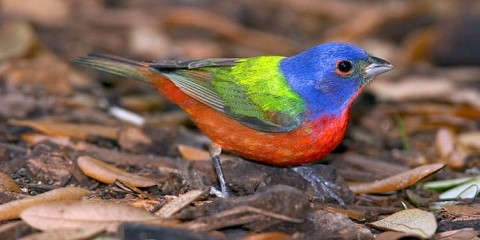
Even though painted buntings are not hostile to humans, they cannot also be described exactly as being friendly. They often show a lot of aggressive behaviors with other members of their group. When they are not seen fighting against each other, they are usually out hiding away from predators. This means that they are not the easiest birds to keep as pets.
These birds are also known to have an angry bit of streak to them. Males, for instance, are highly territorial defending their habitats using aggressive behavior and violent posture. This may also be a reason why these birds are captured easily for the pet trade. The moment that decoys are placed in the territory, they will fly around fast to drive them off.
Male buntings are also known to attack each other over females and food. They will scratch, peck, and strive with their wings and beaks, causing quite a bit of damage right before someone flies away and give up. The result of a fight between buntings can involve bloody wounds, along with several torn-out feathers. On occasion, they can even kill each other.
Out of their breeding grounds, male buntings take out their territories to about several acres through displays and songs. Every male defends its territory aggressively, fighting against intruding males. This is done by grappling, pecking, and striking of their wings.
Painted buntings are also known for their unique flight patterns. These patterns are not observed in other cardinals. For instance, they show a butterfly flight, which uses slow and deep wing movements. They also have a moth flight, with their quivering wing and controlled descent movements.
These types of movements can be quite handy, making them easier to spot in the wild, most especially if you are searching for green females that easily camouflage in trees. Just observe those crazy flying patterns when they are in the air.
Call
There are several ways in which painted buntings communicate with each other. Their main vocalization is a “plick.” This they do in order to call others or to advertise their territory. These birds are also referred to as songbirds. As such, they are capable of carrying a sweet tune for a purpose. These birds exchange high-pitched and bursts of sharp notes in order to pass on messages to other members of their group.
Even though their calls are not really loud, these birds can sing to each other for a continuous 30 seconds or more. They earned the reputation of being noisy, not because of the volume of their call, but because of their uninterrupted burst of song.
Numbers and Threats
As explained by the American Bird Conservancy resource, the overall population size of painted buntings is at about 4.5 million. Another resource shows that the total population of this species is at 13 million, with 80% of these birds spending some of their time within the year in the United States, while 51% of them thrive in Mexico. Painted buntings used to be classified under the Near Threatened category of the IUCN Red List. Their numbers are seen to decrease these days.
The good news, however, is that these birds are not going anywhere. They are currently classified as species of “Least Concern” under the International Union for Conservation of Nature (IUCN) extinction scale. As such, there is no need to fear for the status of this species in the wild.
Among the biggest threats to this species is habitat loss, both in their migration stopover locations and in their breeding grounds. They also fall victim to window collisions, as well as cowbird parasitism. Just like with other colorful birds, painted buntings are popular as cage birds, and are trapped frequently in their wintering habitat, especially in Mexico.
Backyard Tips
Painted Buntings love to eat seeds, especially after the breeding season, starting in mid-summer. This means that they are most likely to visit bird feeders in a yard with denser and low vegetation.
In winter and migration, you can look for painted buntings by targeting seed sources such as bird feeders and weedy fields. In the summer, look for them in secondary growth or edge habitats with quite a dense understory, while paying attention to their metallic chip call, or the rambling, sweet song of a male.
Painted Buntings usually spend a whole lot of time while hiding in dense habitat. This means that you might need to exercise patience when needed. Of course, the wait will all be worth it when you finally see them. It would even be best if you see them in your very own backyard.
If you are interested in seeing painted buntings in action, there are a number of ways in which they can be invited to your property. For one, you can plant bushes and shrubs. This will give the birds a place to make their nest and even sing their songs freely.
You can also choose to fill a bird feeder using their favorite seeds. One good thing about this option is that mixes that are purchased from stores typically include different types of seeds. If you are already getting some for attracting other birds, they can also be used for attracting painted buntings as well.
It will also help a lot if you stop spraying pesticides. These buntings are known to take care of the bugs. All you need to do is to make sure and wait that they are given a chance to raid your beehives and spiderwebs before spraying them.
You can also offer a fresh source of water. These birds will use it for both bathing and drinking. If you have the resources and can afford it, a pond or fountain with fresh, moving water will also attract more birds compared to still water.
Efforts to Save Painted Buntings
Up to this point, several efforts are made by various organizations in order to save painted buntings. The Migratory Birds Program of ABC is collaborating with different partners all throughout the Americas in order to conserve the habitat for species under conservation concern throughout their entire life cycle.
The organization was able to identify and initially establish nine focal geographies, including habitats that are essential to the painted buntings, as well as other birds. Another program of the ABC, the Bird-Smart Glass Program, is a strategy that addresses the deadly problem involving bird collisions. They offer effective ways to homeowners, architects, and building supervisors on how to make glass buildings safer for different migrating birds, including the painted buntings.
How to Care for Painted Buntings
These birds are not really delicate captives, though they thrive well in outdoor aviaries instead of being in a cage. When given a warm shelter, they can also overwinter outdoors. In the wild, painted buntings consume a diet that is nearly composed equally of insects, seeds, and other invertebrates. It is also interesting to see them plucking insects out of webs occurring over much of their range. Even though those in captivity survive on a diet that is seed-based, it is still recommended to introduce variety to their food if you want them to remain in their best condition.
The plumage of male buntings fades in captivity, typically. The most brilliantly colored ones that are found in zoos are usually fed in a diet that is rich in live insects. Exposing the to natural sunlight or by using UVA emitting lamps can also help in maintaining the colors of their feathers.
In captivity, painted buntings are not really easy to breed. However, a compatible pair that does not breed and reproduce will be consistent. Male birds are highly intolerant of each other, which means that fights in between individual birds may result in fatalities occasionally.
Even though painted buntings are not allowed to be kept as pets in the United States, people who are licensed to rehabilitate these birds occasionally have an opportunity to have them for a time. The National Association offers to those who wish to become licensed and trained as rehabilitators. For quite a long time now, Painted Buntings have been a favorite among European collectors, as well as among Mexican aviculturists.
Where to Observe Painted Buntings
Painted buntings are considered as popular attractions at wildlife centers, zoos, as well as other bird sanctuaries. Their colors and songs are always patronized by the crowd. When they are kept safe and away from known predators, their population is also expected to flourish without the need for human intervention.
There are also opportunities to go on bird-watching in order to see these painted buntings in action in the wild. There are tours that are available all throughout the United States. These tours usually have guides that can help you in tracking, spotting, identifying, and capturing photographs of painted buntings.
Availability – Where to Get One?
Through the years, painted buntings are sold in huge numbers in Central America, and often exported from New Orleans. They are often sent by ship to Europe, as well as in other locations, where they are sold for hugely inflated prices.
If you are interested in getting a painted bunting, it is often recommended to get one from a reliable source, particularly breeders. Getting a specimen from these sources prove to be beneficial as it will allow you to get more information regarding the best ways to care for painted buntings.
FAQs
Where can you find painted buntings?
The eastern group of this species breeds from the eastern part of North Carolina, then down south to Northern Florida.
Do painted buntings migrate?
The western group of painted buntings starts their fall migration before molting in areas in Northern Mexico, continuing to migrate down south. This pattern of migration and molting is common among this species, though quite rare among songbirds.
What color is a painted bunting?
Immatures and female buntings are bright yellow and green overall, along with some pale eyering. Even though they are unpatterned, their color overall is brighter and greener than related songbirds.
Why are painted buntings endangered?
Among the biggest factors in the decline of the painted bunting population is habitat loss both on their breeding grounds, as well as their migration stopover locations. This species also fall victim to window collisions. They are also prone to cowbird parasitism.
Is the painted bunting endangered?
Painted buntings used to be considered as Near Threatened, as a result of their decrease in population. Now, it is listed as species of ‘Least Concern.’
What do painted buntings eat?
In the wild, painted buntings consume seeds almost all year round. During the breeding season, they will happily eat insects, including beetles, grasshoppers, snails, as well as various spiders and bugs. They also usually harvest seeds from wheat, St. John’s Wort, wood sorrel, as well as a variety of grasses.
What does a painted bunting nest look like?
Most of the nest is constructed by the females. The nest is usually made out of plant material, including twigs, grass, bark strips, and rootlets. It is then held together with cobwebs and lined often using horsehair.
What seeds do painted buntings like?
A recommended bird feeder to use is a caged feeder that is filled with white millet. Adult painted buntings are generally granivores, which means that they thrive primarily by eating grains and seeds. White millet, therefore, is one of their favorites.
Where do painted buntings nest?
Painted buntings live in open deciduous woods, brushy forest edges, farmlands, and second-growth woodland. The breeding range of this species is spread from Southern Canada to Maine, then south to Northern Florida and Eastern Texas, and then Westward to Southern Nevada.
How do painted buntings look like?
Female buntings are warm gray and brown in color above, with a blue tinge to their tail and wings. They also have buffy wingbars, as well as an unstreaked tan or pale cinnamon breast. Nonbreeding males and juveniles feature a pumpkin-color breast, though their heads and backs are tan and mottled blue.
How big is a painted bunting?
A painted bunting comes with a size of 16 grams.
What plants attract painted buntings?
For most parts of the year, painted buntings are known to be seed-eaters. As such, they favor seeds than native grasses such as switchgrass.
Are painted buntings birds?
The buntings belong to a group of Old World passerine birds that form the genus Emberiza and the only genus that belongs to the Emberizidae family. They are classified as seed-eating birds with conical and stubby bills.
How long do painted buntings live?
Painted buntings can survive up to 10 years. However, most wild buntings may live only half that lifespan.
Are painted buntings rare?
Most records show that the status of painted buntings ranges from uncommon to rare, though some observers report wintering buntings to be common.
How much does a painted bunting weigh?
This species roughly weigh about 0.46 to 0.47 ounces.
Are painted buntings aggressive?
These birds are somewhat aggressive, depending on the situation. Males, for example, are highly territorial, which means that they will aggressively defend their habitats using violent postures.
Are painted buntings friendly?
Even though these birds are not hostile to humans, it is not enough to describe them as friendly. They show aggressive behaviors with other birds of their species. When they are not fighting with others, they are hiding from predators. They are not the species of birds to easily care for pets.
What is the Latin name of painted buntings?
The scientific name of painted buntings is passerina ciris. Under this family, there are two subspecies available, the passerine ciris ciris, and passerine ciris pallidior. They are spread throughout the southeastern US and Mexico. There is no difference between these groups, except for the regions where they live.
What are the predators of painted buntings?
Buntings are frequently under attack from snakes, hawks, shrikes, as well as other predatory birds. Their nests easily become the target because of other animals like stealing and eating their eggs.
Do painted buntings mate for life?
Painted buntings form a monogamous relationship during mating season. They also produce several clutches of eggs with the same partner. However, these pairs might or might not come again together during the next mating season.
When do painted buntings start laying eggs?
Painted buntings begin to mate and lay eggs at about a year of age.
How often do painted buntings lay eggs?
Buntings lay several clutches per mating season because their incubation period is less than two weeks. They need to wait for their hatchlings to grow and leave their nest before starting to reproduce again. This process usually takes a month.
How many eggs do painted buntings lay?
Female buntings typically lay about 3 to 4 eggs at a time, with sizes that are around 1 to 2 centimeters in width.
What color are the eggs of painted buntings?
The eggs of painted buntings are usually white with a blue-gray or gray tint. They also have dark brown spots on the shells.
How do painted buntings call?
There are a number of ways that painted buntings call to communicate. Their main call is a simple “click,” which they use in calling others or marking their territory.
Why are there two separate breeding grounds for painted buntings?
According to biologists, the likeliest explanation for this breeding range gap is that the split happened tens of thousands of years back. This may have happened during the Pleistocene period when the glaciers limited the distance in which Painted Buntings breed. As such, the Gulf of Mexico ended up dividing the breeding range of this species. It was also presumed that they shifted their range as the glaciers receded. However, due to the rigors and hassles of migrating, the divided populations stayed separate.

